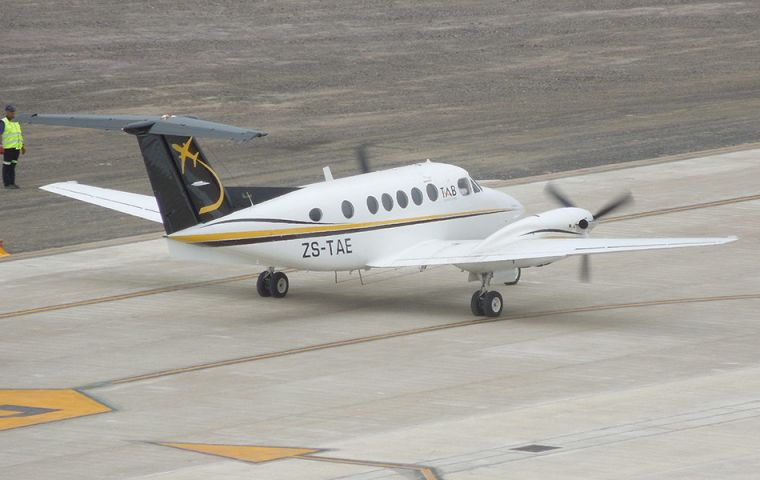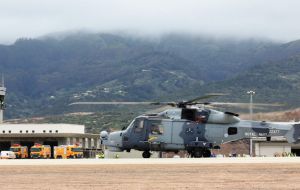MercoPress. South Atlantic News Agency
St Helena airport official opening has been delayed from February to May 2016
 In September, a Beechcraft King Air 200 plane landed at St Helena Airport for the first time, prior to conducting a series of calibration flights.
In September, a Beechcraft King Air 200 plane landed at St Helena Airport for the first time, prior to conducting a series of calibration flights.  The UK Royal Navy's Wildcat helicopter from HMS Lancaster became the first rotary-wing aircraft to land at the airport in St Helena
The UK Royal Navy's Wildcat helicopter from HMS Lancaster became the first rotary-wing aircraft to land at the airport in St Helena The opening of St Helena Airport in the south Atlantic Ocean has been delayed from February 2016 to May 2016 to allow for additional refinement of the aerodrome's infrastructure.
Earlier this month, the island's government announced that runway ILS calibration tests, carried out in September by a team from Flight Calibration Services Limited (FCSL) and TAB Charters (Lanseria), had been unsuccessful. As a result, redesign and relocation of the airfield's Localiser and DVOR would have to be carried out.
“FCSL will return to the Island, possibly in the latter part of 2015 or early 2016, to recalibrate the NavAids following the rectification work,” the government said.
Atlantic Air Lines (London Luton) has already deferred its planned London Gatwick-St Helena flights, operated in conjunction with TUIfly (Netherlands) (Amsterdam), until May. The weekly flights will operate via Banjul, Gambia on both legs using B737-800 equipment.
Comair South Africa, (MN, Johannesburg O.R. Tambo), which will operate scheduled flights to the island from Johannesburg O.R. Tambo with a fortnightly onward sector to Georgetown Wideawake, has also been affected by the delay. It will only be able to commence ticket sales once Air Safety Support International has given St. Helena Airport the official nod.
In September, a Beechcraft King Air 200 plane landed at St Helena Airport for the first time, prior to conducting a series of calibration flights.
In related news it was reported that the Royal Navy in late October achieved a milestone after a Wildcat helicopter on-board its Duke class Type 23 frigate, HMS Lancaster, landed at the new airport on St Helena Island, becoming the first rotary-wing aircraft to land at the airport.
St Helena Island is located 1,200 miles off the African coast and is claimed to be one of the most remote islands in the world. Currently under construction, the new airport is expected to be opened next year.
Flight commander Dave Neyland said: “Landing at St Helena airport was a fantastic opportunity to bring a brand new helicopter to a brand new airport, particularly during such an historic period for the island.
”The airport will usher in a new era for the local community and I was delighted to be a part of that.”
HMS Lancaster's Wildcat, the latest generation of maritime attack helicopter, is designed to carry out a number of missions, including anti-ship, anti-submarine, ship protection, casualty evacuation, battlefield reconnaissance and general utility.
Meanwhile, HMS Lancaster has now completed seven months of its nine-month deployment. During the deployment, the vessel has travelled 28,000 miles and performed 16 port visits over four continents.




Top Comments
Disclaimer & comment rules-

-

Read all commentsThat .. Now the good news may already be intimate Argentina to Chile, to suspend the flight to the islands. Because the stinking, smelling of sheep can leave your hole that place ..
Nov 17th, 2015 - 05:53 pm 0Better late than never.
Nov 19th, 2015 - 07:46 am 0Philippe
Commenting for this story is now closed.
If you have a Facebook account, become a fan and comment on our Facebook Page!